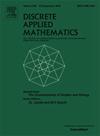On obtaining long m-sequences from low-degree primitive polynomials
IF 1
3区 数学
Q3 MATHEMATICS, APPLIED
引用次数: 0
Abstract
Maximum-length sequences of length (m-sequences) are typically obtained by starting from a primitive polynomial of degree over and configuring a Linear Feedback Shift Register (LFSR) based on that polynomial. In this study, we investigate the generation of long m-sequences based on a primitive polynomial of low degree. Specifically, we investigate a very simple form of an LFSR structure, referred to as Two-Multiplier Split LFSR (2M-SLFSR), that consists of
-bit cells and is based on a single low-degree primitive polynomial of degree over and which can generate, with proper configuration, an m-sequence of length . For example, we show that starting from the primitive polynomial over , a 2M-SLFSR with 2-bit cells can be constructed that yields an m-sequence of length . M-sequences of large length such as obtained from low degree primitive polynomials via LFSR structures akin to 2M-SLFSR find current applications in stream ciphers like those used in SNOW-V and SNOW-Vi.
从低次原始多项式求长m序列
长度为2n−1的最大长度序列(m-序列)通常通过从GF(2)上的n次原始多项式开始,并基于该多项式配置线性反馈移位寄存器(LFSR)来获得。本文研究了基于低次原始多项式的长m序列的生成。具体来说,我们研究了一种非常简单的LFSR结构形式,称为双乘子分裂LFSR (2M-SLFSR),它由mδ位单元组成,基于GF(2)上δ≥2度的单个低阶原始多项式,并且可以在适当的配置下生成长度为2mδ−1的m序列。例如,我们证明了从原始多项式x2+x+1 / GF(2)开始,可以构造一个m=599个2位单元的2M-SLFSR,产生长度为21198−1的m序列。通过类似于2M-SLFSR的LFSR结构从低阶原始多项式中获得的大长度m序列(如2512−1)在流密码中得到了当前的应用,如在SNOW-V和SNOW-Vi中使用的流密码。
本文章由计算机程序翻译,如有差异,请以英文原文为准。
求助全文
约1分钟内获得全文
求助全文
来源期刊

Discrete Applied Mathematics
数学-应用数学
CiteScore
2.30
自引率
9.10%
发文量
422
审稿时长
4.5 months
期刊介绍:
The aim of Discrete Applied Mathematics is to bring together research papers in different areas of algorithmic and applicable discrete mathematics as well as applications of combinatorial mathematics to informatics and various areas of science and technology. Contributions presented to the journal can be research papers, short notes, surveys, and possibly research problems. The "Communications" section will be devoted to the fastest possible publication of recent research results that are checked and recommended for publication by a member of the Editorial Board. The journal will also publish a limited number of book announcements as well as proceedings of conferences. These proceedings will be fully refereed and adhere to the normal standards of the journal.
Potential authors are advised to view the journal and the open calls-for-papers of special issues before submitting their manuscripts. Only high-quality, original work that is within the scope of the journal or the targeted special issue will be considered.
 求助内容:
求助内容: 应助结果提醒方式:
应助结果提醒方式:


